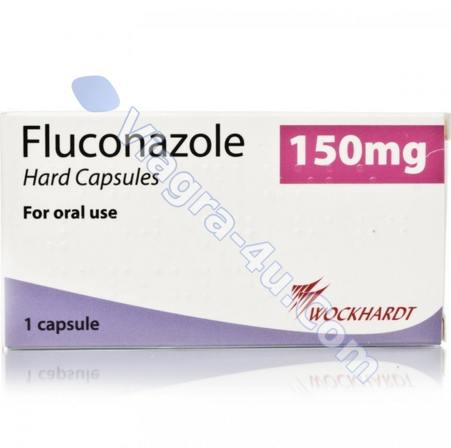Single or multiple use of fluconazole at a dose of 50 mg does not affect the metabolism of phenazone (Antipyrine) when used simultaneously.
The simultaneous use of fluconazole with the following drugs is contraindicated

Cisapride: with the simultaneous use of fluconazole and cisapride, adverse reactions from the heart are possible, incl. arrhythmia ventricular tachysystolic type “pirouette” (torsade de pointes). The use of fluconazole at a dose of 200 mg 1 time / day and cisapride at a dose of 20 mg 4 times / day leads to a pronounced increase in plasma concentrations of cisapride and an increase in the QT interval on the ECG. The simultaneous use of cisapride and fluconazole is contraindicated.
Terfenadine: With the simultaneous use of azole antifungals and terfenadine, serious arrhythmias may occur as a result of an increase in the QT interval. When using fluconazole at a dose of 200 mg / day, an increase in the QT interval has not been established, however, the use of fluconazole at doses of 400 mg / day and above causes a significant increase in the concentration of terfenadine in blood plasma. The simultaneous use of fluconazole at doses of 400 mg / day or more with terfenadine is contraindicated. Treatment with fluconazole at doses less than 400 mg / day in combination with terfenadine should be closely monitored.
Astemizole: the simultaneous use of fluconazole with astemizole or other drugs, the metabolism of which is carried out by the cytochrome P450 system, may be accompanied by an increase in serum concentrations of these drugs. Elevated plasma concentrations of astemizole can lead to prolongation of the QT interval and, in some cases, to the development of arrhythmias of the ventricular tachysystolic pirouette type (torsade de pointes). The simultaneous use of astemizole and fluconazole is contraindicated.

Pimozide: despite the fact that there have been no relevant studies in vitro or in vivo, the simultaneous use of fluconazole and pimozide can lead to inhibition of the metabolism of pimozide. In turn, an increase in plasma concentrations of pimozide can lead to a prolongation of the QT interval and, in some cases, to the development of arrhythmias of the ventricular tachysystolic type “pirouette” (torsade de pointes). The simultaneous use of pimozide and fluconazole is contraindicated.
Quinidine: Despite the fact that there have been no relevant studies in vitro or in vivo, the simultaneous use of fluconazole and quinidine can also lead to inhibition of quinidine metabolism. The use of quinidine is associated with prolongation of the QT interval and, in some cases, with the development of arrhythmias of the ventricular tachysystolic pirouette type (torsade de pointes). The simultaneous use of quinidine and fluconazole is contraindicated.
Erythromycin: The simultaneous use of fluconazole and erythromycin potentially leads to an increased risk of cardiotoxicity (prolongation of the QT interval, torsade de pointes) and, as a result, sudden cardiac death. Concomitant use of fluconazole and erythromycin is contraindicated.
The following medicines are not recommended
Halofantrine: Fluconazole may increase the plasma concentration of halofantrine due to inhibition of the CYP3A4 isoenzyme. It is possible to develop arrhythmias of the ventricular tachysystolic type “pirouette” (torsade de pointes) when used simultaneously with fluconazole, as well as with other azole antifungal drugs, so their combined use is not recommended.
Caution should be exercised when used simultaneously with fluconazole
Amiodarone: The use of amiodarone has been associated with prolongation of the QT interval. Caution should be exercised with the simultaneous use of fluconazole and amiodarone, especially when taking a high dose of fluconazole (800 mg).
Caution should be exercised and, possibly, dose adjustments should be made while using the following drugs and fluconazole
Drugs affecting fluconazole

Hydrochlorothiazide: repeated use of hydrochlorothiazide simultaneously with fluconazole leads to an increase in the concentration of fluconazole in blood plasma by 40%. The effect of this degree of severity does not require a change in the dosage regimen of fluconazole in patients receiving diuretics at the same time, however, the doctor should take this into account.
Rifampicin: the simultaneous use of fluconazole and rifampicin leads to a decrease in AUC by 25% and the duration of T1 / 2 fluconazole by 20%. In patients taking rifampicin at the same time, it is necessary to consider the advisability of increasing the dose of fluconazole.
Drugs Affected by Fluconazole
Fluconazole is a moderate inhibitor of cytochrome P450 (CYP) isoenzymes 2C9 and 3A4. Fluconazole is also an inhibitor of the CYP2C19 isoenzyme. In addition, in addition to the effects listed below, there is a risk of an increase in plasma concentrations of other drugs metabolized by isoenzymes CYP2C9, CYP2C19 and CYP3A4, when used simultaneously with fluconazole. In this regard, caution should be exercised with the simultaneous use of these drugs, and if necessary, such combinations, patients should be under close medical supervision. It should be borne in mind that the inhibitory effect of fluconazole persists for 4-5 days after discontinuation of the drug due to prolonged T1 / 2.
Alfentanil: there is a decrease in clearance and Vd, an increase in T1 / 2 of alfentanil. Perhaps this is due to the inhibition of the CYP3A4 isoenzyme by fluconazole. Alfentanil dose adjustment may be required.
Amitriptyline, nortriptyline: increased effect. The concentration of 5-nortriptyline and / or S-amitriptyline can be measured at the beginning of combination therapy with fluconazole and one week after initiation. If necessary, the dose of amitriptyline / nortriptyline should be adjusted.
Amphotericin B: In studies in mice (including those with immunosuppression), the following results were noted: a small additive antifungal effect in systemic infection with Candida albicans, no interaction with intracranial infection with Cryptococcus neoformans and antagonism with systemic infection with Aspergillus fumigatus. The clinical significance of these results is not clear.
Anticoagulants: like other antifungal agents (azole derivatives), fluconazole, when used simultaneously with warfarin, increases prothrombin time (by 12%), which may lead to the development of bleeding (hematomas, bleeding from the nose and gastrointestinal tract, hematuria, melena). In patients receiving anticoagulants of the coumarin and indandione series and fluconazole, it is necessary to constantly monitor the prothrombin time during therapy and within 8 days after simultaneous use. You should also evaluate the feasibility of adjusting the dose of these anticoagulants.
Azithromycin: with simultaneous oral administration of fluconazole in a single dose of 800 mg with azithromycin in a single dose of 1200 mg, no pronounced pharmacokinetic interaction between both drugs has been established.
Benzodiazepines (short-acting): after oral administration of midazolam, fluconazole significantly increases the concentration of midazolam and psychomotor effects, and this effect is more pronounced after taking fluconazole orally than when using it intravenously. If concomitant therapy with benzodiazepines is necessary, patients taking fluconazole should be monitored to assess the appropriateness of a corresponding reduction in the dose of benzodiazepine. With the simultaneous use of a single dose of triazolam, fluconazole increases the AUC of triazolam by approximately 50%, Cmax by 20-32% and T1 / 2 by 25-50% due to inhibition of the metabolism of triazolam. Dose adjustment of triazolam may be necessary.

Carbamazepine: Fluconazole inhibits the metabolism of carbamazepine and increases the serum concentration of carbamazepine by 30%. The risk of developing carbamazepine toxicity must be considered. The need to adjust the dose of carbamazepine depending on the concentration / effect should be assessed.
Calcium channel blockers: Some calcium channel antagonists (nifedipine, isradipine, amlodipine, verapamil and felodipine) are metabolized by the CYP3A4 isoenzyme. Fluconazole increases the systemic exposure of calcium channel antagonists. Control of the development of side effects is recommended.
Nevirapine: Concomitant use of fluconazole and nevirapine increases the exposure of nevirapine by approximately 100% compared to control data for nevirapine alone. Due to the risk of increased nevirapine excretion with concomitant drug use, some precautions and close patient monitoring are necessary.
Cyclosporine: In patients with a kidney transplant, the use of fluconazole at a dose of 200 mg / day leads to a slow increase in the concentration of cyclosporine. However, with repeated use of fluconazole at a dose of 100 mg / day, changes in the concentration of cyclosporine in bone marrow recipients were not observed. With the simultaneous use of fluconazole and cyclosporine, it is recommended to control the concentration of cyclosporine in the blood.
Cyclophosphamide: with the simultaneous use of cyclophosphamide and fluconazole, an increase in serum concentrations of bilirubin and creatinine is noted. This combination is acceptable given the risk of increased bilirubin and creatinine concentrations.
Fentanyl: there has been a report of one death, possibly associated with the simultaneous use of fentanyl and fluconazole. The impairments are thought to be related to fentanyl intoxication. It has been shown that fluconazole significantly prolongs the elimination time of fentanyl. It should be borne in mind that an increase in the concentration of fentanyl can lead to respiratory depression.


